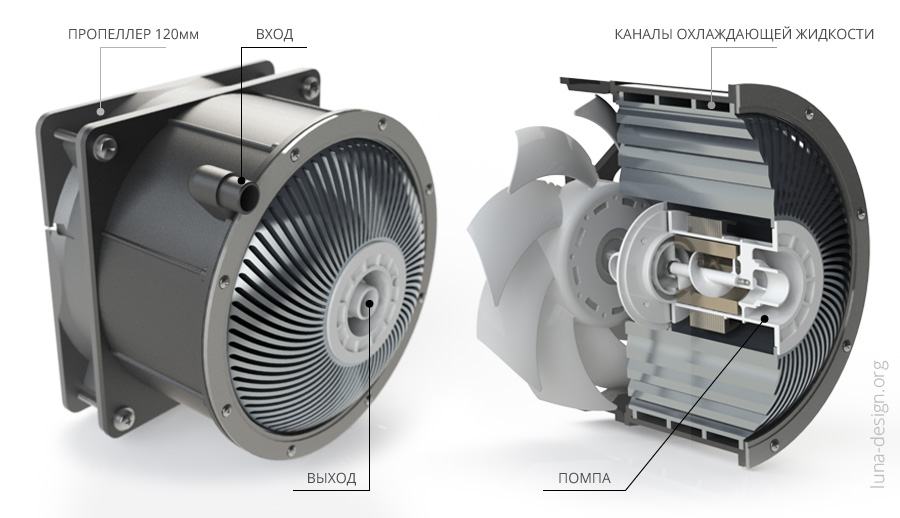Water cooling system. Part 1. Radiator and pump
Working on the previous project , we conducted many experiments and came to the conclusion that in cooling systems it is not so much the size of the radiator and the speed of the air flow that are important, but their optimization. If the heat distributor lamellas are correctly positioned and the air flow is used as efficiently as possible, then with relatively small sizes of the radiator, more efficient heat removal can be achieved.
“Bottlenecks” is when the cross-sectional area of the fluid path decreases or increases. Both that and another leads to difficulty in moving the coolant. In our solution, the cross section of the fluid path anywhere is almost the same and is about 50 mm² (D8mm).

The total area of the radiator cooling lamellas is 3200 cm². The coolant moves in the most efficient zone of the air flow, and its path length is an impressive 96 cm. With an apparent massiveness, the radiator is quite light - about 700 grams. The wall thickness in the cross section is 1.5 mm and this should positively affect the heat transfer. For comparison, the slide on the right shows the heat distribution from our previous project. He quite successfully copes with cooling the entire system in a rather confined space. Moreover, the total area of its cooling lamellas is 4 times smaller.

For the pump, we decided to use the most effective way to move the fluid - a turbine. For one and a half turns, the turbine displaces 7 cm³ of liquid. At a speed of 800 rpm, the theoretical pump capacity is 220 liters per hour. At 2000 rpm - 560 liters. Given the length of the waterway and the resistance of the water blocks, the actual performance will certainly be lower, but this will be quite enough to divert more than 250W of thermal energy. It would be great to develop a control controller that will take into account the cooling needs of both the processor and the video card, and based on this, change the speed of the fluid and the fan speed. The closed design of the pump, where there is completely no contact of water through movable elements with the surrounding air, completely eliminates the leakage of liquid in case of its wear,

We suspect that we could have made a mistake , both in the calculations and in the development of the design. Therefore, we look forward to your comments.
In the next article, we will describe the device of water blocks, both for the processor and for the video card, and we will not forget about the expansion tank. There are also many interesting ideas here.
If you are interested in this project, you can subscribe to our news .
The basic concept:
- The absence of “bottlenecks” in the entire fluid path.
- Maximum airflow utilization.
- The ability to cool any processor in conjunction with a video card with a capacity of up to 200W.
- Simplicity of assembly and "charging" of the entire structure with coolant.
- Cooling with any 120 mm fan.
“Bottlenecks” is when the cross-sectional area of the fluid path decreases or increases. Both that and another leads to difficulty in moving the coolant. In our solution, the cross section of the fluid path anywhere is almost the same and is about 50 mm² (D8mm).

Heat distributor
The total area of the radiator cooling lamellas is 3200 cm². The coolant moves in the most efficient zone of the air flow, and its path length is an impressive 96 cm. With an apparent massiveness, the radiator is quite light - about 700 grams. The wall thickness in the cross section is 1.5 mm and this should positively affect the heat transfer. For comparison, the slide on the right shows the heat distribution from our previous project. He quite successfully copes with cooling the entire system in a rather confined space. Moreover, the total area of its cooling lamellas is 4 times smaller.

water pump
For the pump, we decided to use the most effective way to move the fluid - a turbine. For one and a half turns, the turbine displaces 7 cm³ of liquid. At a speed of 800 rpm, the theoretical pump capacity is 220 liters per hour. At 2000 rpm - 560 liters. Given the length of the waterway and the resistance of the water blocks, the actual performance will certainly be lower, but this will be quite enough to divert more than 250W of thermal energy. It would be great to develop a control controller that will take into account the cooling needs of both the processor and the video card, and based on this, change the speed of the fluid and the fan speed. The closed design of the pump, where there is completely no contact of water through movable elements with the surrounding air, completely eliminates the leakage of liquid in case of its wear,

We suspect that we could have made a mistake , both in the calculations and in the development of the design. Therefore, we look forward to your comments.
In the next article, we will describe the device of water blocks, both for the processor and for the video card, and we will not forget about the expansion tank. There are also many interesting ideas here.
If you are interested in this project, you can subscribe to our news .
